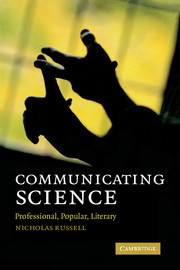Book contents
- Frontmatter
- Contents
- Introduction: What this book is about and why you might want to read it
- Prologue: Three orphans share a common paternity: professional science communication, popular journalism and literary fiction are not as separate as they seem
- Part I Professional science communication
- 1 Spreading the word: problems with publishing professional science
- 2 Walk like an Egyptian: the alien feeling of professional science writing
- 3 The future's bright? Professional science communication in the age of the internet
- 4 Counting the horse's teeth: professional standards in science's barter economy
- 5 Separating the wheat from the chaff: peer review on trial
- Part II Science for the public: what science do people need and how might they get it?
- Part III Popular science communication: the press and broadcasting
- Part IV The origins of science in cultural context: five historic dramas
- Part V Science in literature
- Index
- References
5 - Separating the wheat from the chaff: peer review on trial
Published online by Cambridge University Press: 02 December 2010
- Frontmatter
- Contents
- Introduction: What this book is about and why you might want to read it
- Prologue: Three orphans share a common paternity: professional science communication, popular journalism and literary fiction are not as separate as they seem
- Part I Professional science communication
- 1 Spreading the word: problems with publishing professional science
- 2 Walk like an Egyptian: the alien feeling of professional science writing
- 3 The future's bright? Professional science communication in the age of the internet
- 4 Counting the horse's teeth: professional standards in science's barter economy
- 5 Separating the wheat from the chaff: peer review on trial
- Part II Science for the public: what science do people need and how might they get it?
- Part III Popular science communication: the press and broadcasting
- Part IV The origins of science in cultural context: five historic dramas
- Part V Science in literature
- Index
- References
Summary
New times call for new men. The economy of computer and communication technologies has spawned new millionaires. Like successful businessmen of previous generations, they have turned to philanthropy and are giving their money away to good causes. In the past, if such philanthropists invested in science or technology, they had projects evaluated by the traditional process of peer review. Proposals were considered by panels of scientists specialized in the fields concerned.
But the new silicon millionaires do not favour this model. They want things to be riskier and more like their own business practice. They select areas of science that interest them personally (often biomedicine or neurophysiology) and target funds there. They often hire a leading expert in the chosen field as a technical advisor to network with other field leaders and identify people with interesting ideas whom they encourage to apply for funds. They are trying to spot winners, with the inevitable fall-out of failed projects hopefully counterbalanced by enough successes. The system has an element of peer review (opinions of field leaders are sought) and some early promise in track record is necessary, but much more emphasis is placed on searching out promising innovators to make applications that look like business plans. The millionaires make quick and less bureaucratic decisions than conventional funding agencies using traditional peer review, although the risks of failure are higher.
These new philanthropists are not the only ones questioning peer review as a gold standard in quality control in choosing projects to fund. The dissatisfaction with peer review runs deeper and some people are calling into question the whole system of quality control in science based on review and its modifications. […]
- Type
- Chapter
- Information
- Communicating ScienceProfessional, Popular, Literary, pp. 53 - 66Publisher: Cambridge University PressPrint publication year: 2009



